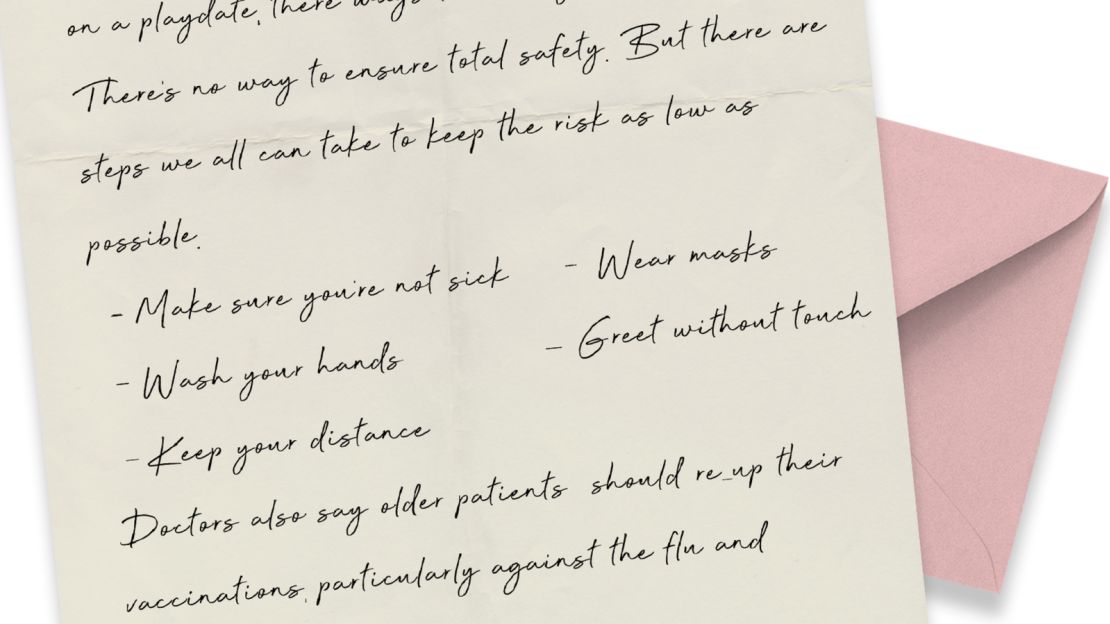Dear Grandma,
We know you’re itching to see your grandkids after spending the last few weeks in isolation. But a visit with family may not be the safest idea at the moment.
Staying home is the best way to stop the spread of the coronavirus. But if your heart is set on a playdate, there are ways to make your visit safer.
Please remember, though, that there’s risk involved with seeing your grandchildren even if you can resist giving them a hug.
1. Please consider the risk
We talked to Dr. Samir Sinha. He’s the director of Geriatrics for the Sinai Health System and the University Health Network in Toronto. And this is what he says:
Until there’s a vaccine, the most vulnerable people should continue to stay home if they can. That includes grandparents over 60 like you and people with chronic illnesses.
You see, people in those categories are more likely to become severely ill if they contract the coronavirus. We don’t want that to be you.
“I think the pandemic has been really hard for everybody, but social isolation is a particular issue for older adults,” he says. “One of the greatest joys for older people is seeing younger people in their lives and having intergenerational connections.”
It’s a tricky balance, we know.
On one hand, meaningful connections are hugely important – they can enrich and even prolong your life. But seeing a loved one means you’ll interact with people you haven’t seen in weeks who’ve spent their isolation in a different environment than you. You have to decide whether that risk is worth it to you.
2. Let’s talk about it
Maybe you think we, your loving family members, have banned you from visiting.
“There is this tension between families where older people feel their families are being overprotective of them or infringing on their rights,” Sinha says.
It doesn’t have to be a stalemate. Let’s talk it out.
“It should be a shared choice,” Sinha says. “That person hears why their loved one actually wants to protect them, and this prompts a conversation and helps the person understand, ‘While I’m worried about you getting Covid-19, I appreciate that you want to protect me from that.’”
Discuss why you want to visit and acknowledge the risk involved.
- Have you been staying home and limiting your exposures?
- Or have you had to work daily in environments that could expose them to the virus.
If it’s the second one, it’s best to visit virtually.

3. Follow the safest protocol
There’s no way to ensure total safety. But there are steps we all can take to keep the risk as low as possible.
Read over Sinha’s recommendations, which he developed with the American Red Cross Scientific Advisory Council:
- Be well. Make sure you’re not sick when you plan to visit, whether that means a runny nose, fever or stomachache – any form of illness. We won’t let you visit if any of us are sick, either.
- Wear masks. Keep it on for the duration of your visit, if you can. If you’re asymptomatic, masks help keep you from breathing out the virus. (And you can learn how to make your own.)
- Wash your hands. As soon as you walk in, wash your hands for 20 seconds with soap and water. As your family, we’ll disinfect frequently touched surfaces before you arrive.
- Greet without touch. Try not to greet us with a kiss or hug, as hard as that may be to resist.
- Keep your distance. You know the drill: Keep at least six feet of distance. We know, it’s weird.
Sinha also recommends his older patients re-up their vaccinations, particularly against the flu and pneumonia.
If you do come down with coronavirus, there’s a higher chance you may also become infected with pneumonia or the flu at the same time. Multiple illnesses will stress out your immune system.
4. Pace yourself when you’re visiting
So, it’s decided – you’re visiting. Now you may need to pick which family members get first dibs on you.
When you visit multiple people, the possibility that you’ll be exposed to the virus grows, Dr. William Schaffner told us. He’s an infectious disease specialist at the Vanderbilt University School of Medicine.
“Start off with a few people, or just one at a time,” Schaffner says. “This is not the time to have a once-in-20-years family reunion.”
Here’s another consideration that may sway your choice: Children younger than 5 may have trouble adhering to social distancing measures. If they (or you) can’t resist bear hugs or slobbery cheek kisses, consider visiting families with older children, Sinha says.
5. Let’s meet outside
Schaffner suggests we choose the great outdoors as our reunion venue, like a park or garden where we can stay safely distant from others.
Transmission is unlikely outside, as long as we’re keeping 6 feet apart, thanks to constant air flow, Schaffner says. But it’s best to wear a mask anyway to prevent asymptomatic transmission should we accidentally come close.
One last thing: We, your doting relatives, love you dearly. These guidelines aren’t ideal, and we’ve never had to do anything like this before. But if we take these measures now, we’ll do our part to stop the spread of the coronavirus. And when this pandemic is through, we can bring on the bear hugs again.
Oh, and keep washing your hands.
Yours sincerely,
The people who love you.
P.S. Here are some helpful links, if you haven’t seen them yet:
- This is a searchable bank of any coronavirus question you may have
- Here’s everything you need to know about proper social distancing
- These are some tips on how you can coronavirus-proof your home
- Please read this before you go out in public
- Finally, if you’re feeling helpless, here’s a list of places you can donate




